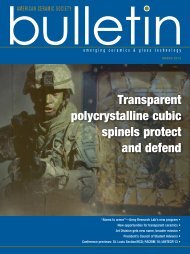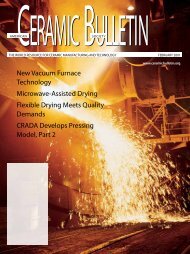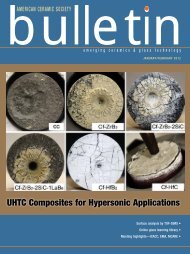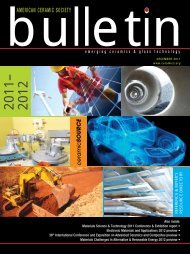American Ceramic Society Bulletin
American Ceramic Society Bulletin
American Ceramic Society Bulletin
You also want an ePaper? Increase the reach of your titles
YUMPU automatically turns print PDFs into web optimized ePapers that Google loves.
esearch briefs<br />
X-ray microtomography and finite element<br />
analysis to examine in each of the<br />
90 specimens how trabecular scaling<br />
changes in relation to size, and how<br />
bone mechanics change in relation to<br />
the scaling. For materials scientists,<br />
here are the key findings (some of<br />
which may be a little counterintuitive):<br />
• From animal to animal, the bone<br />
volume fraction does not substantially<br />
scale with creature size;<br />
• Although the bone volume fraction<br />
does not increase greatly, the trabeculae<br />
in the femur of larger animals<br />
are thicker, farther apart;<br />
• Also in larger animals, the trabeculae<br />
are less densely connected (the<br />
number per unit volume is considerably<br />
fewer than in small animals; and<br />
• Finite element modeling explains<br />
that scaling does not alter the bulk<br />
stiffness of trabecular bone, but probably<br />
mitigates strain on the scale of the<br />
osteocyctes.<br />
The authors suggest that the differences<br />
in how trabeculae grow in various<br />
animals might be “an interspecific<br />
manifestation of bone tissue’s drive to<br />
maintain mechanical homeostasis. It<br />
appears that changes in geometry are<br />
preferred over increased bone mass.”<br />
They and other researchers note that<br />
this preference “may be an adaption<br />
that limits the physiological cost of producing,<br />
maintaining and moving more<br />
tissue.”<br />
So, what are broader implications? If<br />
one is thinking about how to develop a<br />
“smart material” that could adapt to a<br />
changing environment, there is a lesson<br />
in bones: The modeling and remodeling<br />
of trabeculae and surrounding<br />
internal structures seem to be a massefficient<br />
strategy for dealing with strain.<br />
Elephants do not require thick, dense<br />
bones to support their loads. They just<br />
use their internal capacity to alter their<br />
bone structure.<br />
“We can learn a lot from nature,<br />
such as how nature develops these<br />
strong, lightweight structures,” advises<br />
Shefelbine in a story in The Engineer.<br />
“We could adopt this in design. It could<br />
inform how people develop structural<br />
foams.” In particular, the researchers<br />
say, “This may represent a new<br />
approach to designing cellular solids<br />
for engineered structures of different<br />
scales.”<br />
The IC research team also has created<br />
an open-source computer program<br />
(“BoneJ”) for examining the number,<br />
thickness and spacing of trabeculae as<br />
well as analyses of whole bones.<br />
Visit Imperial College, www3.imperial.ac.uk;<br />
and BoneJ, www.bonej.org/ n<br />
Evidence mounts that<br />
‘pseudogap’ is distinct phase in<br />
superconducting materials<br />
Investigators in the field of hightemperature<br />
superconductors have<br />
been stumped for some time about<br />
what is occurring between when the<br />
temperature of a material drops to the<br />
point (T*) where electrons begin to<br />
form Cooper pairs (T c ) and the critical<br />
temperature for full superconductivity.<br />
Heretofore, this odd transitional region<br />
has been dubbed a “pseudogap,” but<br />
now a collaborative research project has<br />
revealed that three different tests suggest<br />
the pseudogap is actually a distinct<br />
phase.<br />
The collaboration included scientists<br />
from the Lawrence Berkeley National<br />
Laboratory, the University of California<br />
at Berkeley, Stanford University and<br />
the SLAC National Accelerator Lab.<br />
Their results were recently published in<br />
Science (doi:10.1126/science.1198415).<br />
Led by Zhi-Xun Shen, director of<br />
the Stanford Institute for Materials and<br />
Energy Science at SLAC and a professor<br />
of physics at Stanford University, the<br />
group focused only on Pb-Bi2201 (a lead<br />
bismuth strontium lanthanum copper<br />
oxide) because of the materials relatively<br />
wide range between T* and T c .<br />
Previous research supported two separate<br />
theories about the odd pseudogap:<br />
One theory is that it is just a range of<br />
gradual transition to superconductivity,<br />
and the other is that it is a state of<br />
material distinct from superconductiv-<br />
ity and normal “metallicity” with a<br />
quantum critical point.<br />
“Promising as the ‘quantum critical’<br />
paradigm is for explaining a wide range<br />
of exotic materials, high-T c superconductivity<br />
in cuprates has stubbornly<br />
refused to fit the mold. For 20 years, the<br />
cuprates managed to conceal any evidence<br />
of a phase-transition line where<br />
the quantum critical point is supposed<br />
to be found,” says Joseph Orenstein in<br />
a news release from the Berkeley Lab.<br />
Orenstein works in the lab’s Materials<br />
Sciences Division and is a professor of<br />
physics at UC Berkeley, whose group<br />
conducted one of the research team’s<br />
three experiments.<br />
According to the release, the hope<br />
is that once researchers can wrap their<br />
thinking around the concept of a quantum<br />
critical point (X c ), new routes<br />
to superconductivity can be found.<br />
“This is a paradigm shift in the way we<br />
understand high-temperature superconductivity,”<br />
says Ruihua He, lead author<br />
with Makoto Hashimoto. “The involvement<br />
of an additional phase, once<br />
fully understood, might open up new<br />
possibilities for achieving superconductivity<br />
at even higher temperatures<br />
in these materials.” These two worked<br />
with Shen at SIMES and also worked<br />
at Stanford’s Department of Applied<br />
Physics and at Berkeley Lab’s Advanced<br />
Light Source.<br />
One of the tests they conducted<br />
involved angle-resolved photoemission<br />
spectroscopy to track the kinetic<br />
energy and momentum of the emitted<br />
electrons over a temperature range. In<br />
another test, investigators measured<br />
changes in rotations of the plane of<br />
polarization light reflected from the<br />
same Pb-Bi2201 sample under a zero<br />
magnetic field (magneto optical Kerr<br />
effects). The rotations are proportional<br />
to the net magnetization of the sample<br />
at various temperatures. Orenstein’s<br />
group performed the third test, a study<br />
of time-resolved reflectivity of the<br />
Pb-Bi2201 sample.<br />
None of these tests were particularly<br />
novel – except that this time they<br />
22 <strong>American</strong> <strong>Ceramic</strong> <strong>Society</strong> <strong>Bulletin</strong>, Vol. 90, No. 4






